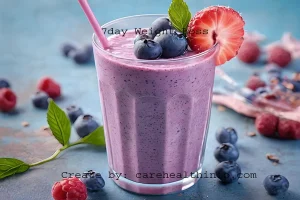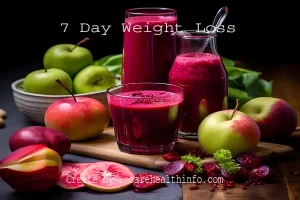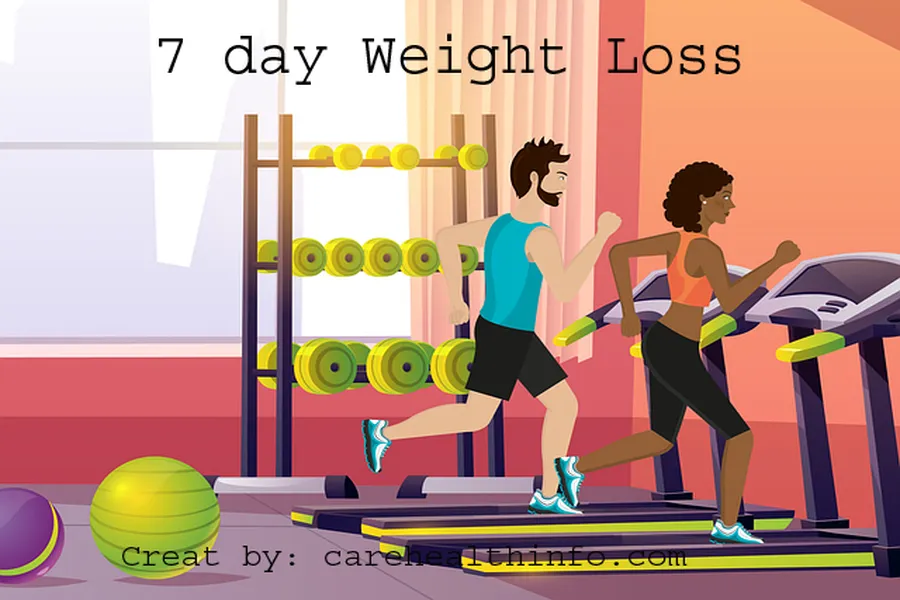A 7-day diet plan for weight loss focuses on balanced meals with controlled portions.
Embarking on a weight loss journey can feel overwhelming, but a structured 7-day diet plan simplifies the process. This plan emphasizes nutritious foods that not only promote weight loss but also enhance overall well-being. By incorporating a variety of fruits, vegetables, lean proteins, and whole grains, you can fuel your body effectively while shedding excess pounds.
Each day features a balanced menu, ensuring you receive essential nutrients without feeling deprived. Staying hydrated and mindful of portion sizes plays a crucial role in achieving your weight loss goals. This approach fosters sustainable habits for long-term success, making it easier to maintain your desired weight.
How to Quick Weight Loss?
Quick weight loss attracts many people. It promises rapid results. A 7-day diet plan can help you shed pounds fast. But, it’s essential to approach it wisely. Must understanding this benefits.
The Allure Of Fast Results
Fast results can be very tempting. They offer hope and motivation. Here are some reasons why quick weight loss is appealing:
- Immediate changes in appearance
- Boost in confidence
- Motivation to continue healthier habits
Many people desire to see results quickly. This desire can lead to drastic measures. A structured 7-day plan can provide a safe way to start.
Health Considerations Before Starting
Before starting any diet, consider your health. Quick weight loss may not suit everyone. Here are some health factors to evaluate:
| Health Factor | Consideration |
| Current Weight | Extreme weight loss may harm your health. |
| Medical Conditions | See a physician if you suffer from any ailments. |
| Dietary Needs | Ensure the plan meets your nutritional needs. |
| Physical Activity | Balance diet with regular exercise for best results. |
Always listen to your body. Stay hydrated and nourish it well. Quick weight loss can be effective, but safety is crucial.
Setting Realistic Goals
It’s true that to selecting effective goals for weights loss. Focus on achievable milestones to maintain your progress.

Determining Healthy Weight Loss
Healthy weight loss means shedding pounds safely. This rate is sustainable and protects your health. Use the following methods to determine your weight loss goals:
- Calculate your Body Mass Index (BMI).
- Assess your current eating habits.
- Consider your activity level.
- Set a target weight based on health guidelines.
For example, if you weigh 180 pounds, a goal of losing 10% of your body weight is realistic. This means aiming for 162 pounds.
Day 1: Kickstarting Your Metabolism
Day 1 is all about jumpstarting your metabolism. This day sets the stage for your weight loss journey. Focus on cleansing your body and nourishing it with healthy foods. Start strong to maintain momentum throughout the week.
Morning Detox Rituals
Begin your day with a refreshing detox. This ritual helps clear toxins and boosts energy levels. Here are some effective detox options:
- Warm Lemon Water: Mix the juice of half a lemon in warm water.
- Green Tea: Brew a cup of green tea. Its antioxidants support metabolism.
These drinks prepare your body for the day ahead. They enhance hydration and stimulate your metabolism.
Understanding The Fasting Window
Intermittent fasting is alternating periods of eating and fasting. Typical techniques consist of:
- 16/8 method: Eat within an 8-hour window after 16 hours of fasting.
- 5:2 method: Eat normally for 5 days, limit calories to 500-600 for 2 days.
- Eat-Stop-Eat: a once or twice-weekly 24-hour fast.
Choose a method that suits your lifestyle. For today, we will focus on the 16/8 method. This means you will eat between 12 PM and 8 PM.
Meal Planning For Optimal Results
Planning meals is key to success. Here’s a simple meal plan for your eating window:
Day 3: Boosting Fat Burn With Exercise
On Day 3 of your 7-day diet plan, focus on boosting fat burn through effective exercise. Exercise complements your diet. It helps burn calories and builds muscle. Incorporate various workouts to maximize results.
Effective Workouts For Weight Loss
Choose workouts that raise your heart rate. Here are some effective options:
- High-intensity interval training (HIIT) consists of brief, high-intensity activity bursts interspersed with rest.
- Cardiovascular Exercises: 30 minutes of swimming, cycling, or running.
- Strength Training: Use weights to build muscle.
- Yoga: Increases flexibility and can reduce stress.
Combine these workouts for best results. Every day, try to get in at least 30 minutes of exercise.
Balancing Exercise And Nutrition
Nutrition plays a crucial role in weight loss. Pair your workouts with healthy meals. Here’s a simple meal plan for Day 3:
| Meal | Suggestions |
| Breakfast | Berries and nuts sprinkled over oatmeal. |
| Lunch | Grilled chicken salad with mixed greens. |
| Snack | Greek yogurt with honey. |
| Dinner | Baked salmon with steamed broccoli. |
Stay hydrated. Drink plenty of water throughout the day. Proper hydration aids in fat burning and recovery.
Balance your exercise routine with nutritious meals. This ensures you gain energy and maintain motivation. Stick to your goals. Each workout counts!
Day 4: The Effects of Hydration on Weight
Day 4 focuses on the importance of hydration for weight loss. Staying hydrated plays a key role in your journey. Water affects metabolism and can curb hunger. Let’s explore how water impacts weight loss.
The Role Of Water In Weight Loss
Water is essential for overall health. It helps in many ways:
- Enhances Metabolism: Water consumption might raise your metabolic rate.
- Reduces Appetite: Sometimes thirst is mistaken for hunger.
- Enhances Exercise Performance: Proper hydration improves endurance.
- Aids Digestion: Water helps break down food effectively.
Here’s a table showing the benefits of hydration:
| Benefit | Explanation |
| Increases Energy | Staying hydrated keeps your energy levels stable. |
| Improves Skin Health | Water helps maintain skin elasticity and glow. |
| Flushes Toxins | Water helps remove waste from the body. |
Signs of dehydration include:
- Dry mouth
- Fatigue
- Dark yellow urine
- Dizziness
Staying hydrated is crucial for weight loss success. Keep an eye on your consumption and drink lots of water. Make staying hydrated a top priority in your everyday activities.
Day 5: Mastering Mindful Eating
Day 5 focuses on mastering mindful eating. This technique helps you develop a healthier relationship with food. It encourages awareness of your eating habits. Mindful eating can lead to better choices and weight loss.
Techniques To Enhance Awareness
Enhancing awareness is key to mindful eating. Use these techniques to improve your experience:
- Slow Down: Chew your food slowly. Enjoy each bite.
- Eliminate Distractions: Avoid screens while eating. Focus on your meal.
- Use Your Senses: Take in the flavors, sensations, and colors.
- Be grateful for what you eat and the nourishment it provides.
- Check In with Yourself: Ask how you feel before and after eating.
Controlling Portions And Cravings
Controlling portions helps prevent overeating. Use these strategies to manage cravings:
- Use Smaller Plates: Smaller plates trick your mind into feeling full.
- Measure Servings: To ensure precise servings, use measuring cups.
- Stay Hydrated: Drink water before meals. It reduces hunger.
- Wait it Out: If cravings hit, wait 10 minutes before eating.
- Choose Healthy Snacks: Opt for fruits or nuts instead of junk food.
These techniques will help you master mindful eating.
Day 6: Incorporating Whole Foods
Day 6 focuses on incorporating whole foods into your diet. Whole foods are natural and unprocessed. This day emphasizes making better food choices. Let’s explore how to identify whole food sources and the benefits of cutting processed foods.

Identifying Whole Food Sources
Fruits, vegetables, whole grains, legumes, nuts, and seeds are examples of whole foods. These foods are packed with nutrients. Here’s a list of some whole food sources:
- Fruits: Apples, bananas, berries, oranges
- Vegetables: Spinach, carrots, broccoli, bell peppers
- Whole Grains: Brown rice, quinoa, oats, barley
- Legumes: Lentils, chickpeas, black beans, peas
Choose these foods over processed options. They provide vitamins and minerals.
Benefits Of Cutting Processed Foods
Cutting processed foods has many benefits:
- Weight Loss: Whole foods are lower in calories.
- Improved Energy: Natural foods boost energy levels.
- Better Digestion: Fiber helps the digestive system.
- Reduced Cravings: Whole foods help control hunger.
- Enhanced Mood: Nutrient-rich foods can improve mental health.
Preservatives, bad fats, and added sugars are frequently found in processed foods. These can lead to weight gain. They can also cause health issues over time. Choosing whole foods leads to a healthier lifestyle.
Today, plan meals using whole foods. Enjoy fresh fruits and vegetables. Whole grain options. Snack on nuts and seeds. This will set you on the right path for your weight loss journey.
Day 7: Preparing For Long-term Success
Day 7 marks a significant milestone. This day focuses on maintaining your hard-earned weight loss. It’s essential to reflect, plan, and set yourself up for future success.
Reflecting On The Week’s Progress
Take a moment to consider your journey this week. Reflecting helps reinforce good habits and boosts motivation. Here are some points to consider:
- What meals did you enjoy the most?
- Which workouts felt best for you?
- Did you face any challenges?
- How did your body feel throughout the week?
Jot down your thoughts in a journal. This can help identify patterns and preferences. Celebrate your wins, no matter how small.
Strategies To Maintain Weight Loss
Weight loss is just the beginning. Bellow the chart:
| Strategy | Description |
| Set Realistic Goals | Focus on achievable targets. Aim for gradual progress. |
| Stay Active | Incorporate exercise into your daily routine. Find activities you enjoy. |
| Meal Prep | Plan your meals ahead. This reduces unhealthy choices. |
| Hydrate | Drink plenty of water. It helps control hunger. |
| Track Your Progress | Keep a log of your weight and meals. This increases accountability. |
Incorporate these strategies into your daily life. They help ensure lasting results. Remember to stay patient and persistent.
With these tips, you can successfully transition from this 7-day plan into a healthier lifestyle. Every step counts on this journey.
Supplementing The Diet Plan
Supplementing your 7-Day Diet Plan can enhance weight loss efforts. Proper supplements help fill nutritional gaps. They can support metabolism and overall health. Choosing the right supplements is key to success.
When To Consider Supplements
Consider supplements in these scenarios:
- Busy Lifestyle: Limited time for meal prep.
- Diet Restrictions: Vegan, vegetarian, or allergies.
- Weight Loss Plateaus: Stalled progress in losing weight.
- Increased Activity: More exercise requires extra nutrients.
Choosing Quality Products
Choosing quality supplements is crucial.
- Third-Party Testing: Ensures safety and potency.
- Transparency: Clear ingredient labeling.
- Reputable Brands: Research brand reputation and reviews.
- Proper Dosage: Follow recommended serving sizes.
Popular supplements for weight loss include:
| Supplement | Benefits |
| Protein Powder | Supports muscle growth and satiety. |
| Fiber Supplements | Aids digestion and promotes fullness. |
| Multivitamins | Fills nutritional gaps in the diet. |
| Fat Burners | Boosts metabolism and energy levels. |
Dealing With Plateaus
Plateaus can be frustrating. Your weight may stop changing for days or weeks. Here are some solutions:
- Change Your Routine: Adjust your meals or exercise.
- Increase Activity: Add more movement to your day.
- Stay Hydrated: Drink enough water daily.
Sometimes, a small change can break the plateau. Be patient. Your body needs time to adjust.
Staying Motivated
Staying motivated is key. It can be hard to keep going. Here are some tips:
- Establish Aim for Small, Achievable Goals: Set realistic goals.
- Find a Buddy: Talk to a friend about your journey.
- Reward Yourself: Treat yourself for milestones.
- Visualize Progress: Keep track with photos or charts.
Remember, every step counts. Celebrate small victories. Stay focused on your end goal.
Conclusion: Next Steps After The 7-day Plan
Completing a 7-day diet plan is a great start. You may feel more energized and motivated. Now, focus on the next steps to keep this momentum going.
Evaluating Outcomes
Take time to assess your progress. Here Some factes
- Weight Loss: Did you meet your goals?
- Energy Levels: Do you feel more active?
- Hunger: Are you managing cravings effectively?
- Body Measurements: Check waist, hips, and more.
Record your findings. A simple table can help track your results:
| Metric | Before Diet | After 7 Days |
| Weight (lbs) | 150 | 145 |
| Waist (inches) | 32 | 30 |
| Energy Level (1-10) | 5 | 8 |
Creating A Sustainable Lifestyle
Transition from the 7-day plan to a long-term strategy. Here are some tips:
- Set Reasonable Goals: Aim for a steady weight loss.
- Incorporate Variety: Mix foods to avoid boredom.
- Stay Hydrated: Drink plenty of water daily.
- Exercise Frequently: Make physical activity a part of your daily schedule.
- Track Your Progress: Keep tabs using journals or apps.
Choose foods that nourish your body. Limit processed foods and sugary snacks.
Remember, consistency is key. Celebrate small wins. This journey is about lifestyle changes, not just a quick fix.
Final Thoughts:
Following a 7-day diet plan can kickstart your weight loss journey. Consistency is key to achieving lasting results. Pair your diet with regular exercise for optimal benefits. Remember, healthy habits take time to form. Stay motivated and track your progress.
Embrace this journey toward a healthier, happier you.

